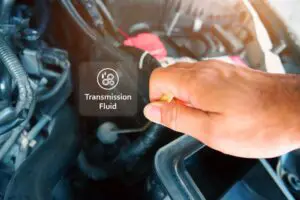Regular maintenance is an essential aspect of owning a vehicle, and one crucial part of that maintenance is changing the transmission fluid.
Older models of the Ford F150 had this process to be incredibly easy. The newer models have people questioning where to add transmission fluid Ford F150.
Here, the transmission fluid needs to be added under the car, as this is where you can access the screw in the dipstick. If you want to learn the entire process, read the article until the end.
Table of Contents
Where Is The Transmission Fluid Located On A Ford F150?

Depending on the model of your Ford F150, you will have two different methods to locate where the transmission fluid is.
For older Ford F150 trucks, the transmission fluid dipstick is located toward the left side of the engine compartment.
To access it, you must lift the hood and look for the dipstick that goes back into the transmission. Pre 2010, it was quite simple to find the transmission.
For post-2010 Ford F150 models, checking the transmission fluid can be more challenging.
This is so much so that the Ford Motor Company recommends only certified mechanics check the transmission fluid.
This can make it nearly impossible for vehicle owners to perform this task themselves. You must climb underneath the truck and remove the heat shield to access the dipstick.
This will reveal a small bolt that goes into the side of the transmission pan, and the dipstick will be located on the inner side of it.
Only attempt this if you have the proper tools and knowledge.
How To Add And Check Transmission Fluid In Your Ford F150
In this section, I will write a step-by-step guide on adding transmission fluid to your Ford F150.
For older vehicles, this was easy as all you had to do was pop open the bonnet, locate the fill plug, and add transmission. This is no longer the case in the latest Ford F150 models.
Step 1. Park Your Truck On A Level Surface
The first step to adding transmission fluid to your Ford F150 is to park it on a level surface.
This is important as it allows you to get an accurate reading of the fluid level in the transmission.
This step also ensures that the transmission fluid is evenly distributed and settles to the bottom of the pan.
It is important to do so as you do not want to overfill or underfill the transmission fluid since it can lead to damage.
To complete this step, you should find a flat area, not on an incline, and properly park your Ford F150.
Once you find a suitable location, apply the parking brake and shift the transmission into park or neutral. This will depend on your transmission type.
A good idea is to drive the vehicle till the transmission fluid reaches close to 206 degrees in temperature.
Ensure the vehicle is turned off and the engine is cool before proceeding to the next step.
Step 2. Locate The Transmission Fill Plug
As mentioned, the latest Ford F150s do not have transmission dipsticks.
Instead, you need to locate the fill plug on the side of the transmission. You can find it by looking underneath the vehicle.
The fill plug is typically located on the driver’s side of the transmission. This plug is usually a small bolt that is mostly silver or black.
You will want to get safely underneath the vehicle. You may need to use a flashlight to properly and easily locate the fill plug.
Once you find the fill plug, ensure you have the correct size wrench to remove it.
It is also important to note that the location of the fill plug may vary depending on the model and year of your Ford F150.
This means it is important to consult your owner’s manual to ensure you locate the correct fill plug.
Ensure you have the proper equipment to lift the car as well. This can make the entire process a lot easier and safer.
Step 3. Remove The Fill Plug

This step is relatively straightforward, but taking caution and wearing the proper safety gear is recommended.
This is because the exhaust should still be hot from your earlier driving.
Wear proper gloves and long sleeves to avoid getting burned.
After locating the fill plug, you must remove it to add the transmission fluid. Use the correct size wrench to loosen the bolt and remove it from the transmission.
Typically, the screw in the dipstick uses a 19mm nut. Be careful not to drop or lose the bolt, as it is an essential part of the vehicle.
Once you remove the fill plug, you may notice some fluid coming out. This is normal, as it is a sign that the transmission fluid is at the correct level.
If no fluid comes out, it may indicate that your transmission is low on fluid.
Step 4. Add Transmission Fluid
Now that the fill plug is removed, you can safely add the transmission fluid to your Ford F150.
Make sure to use the correct type of transmission fluid specified in your owner’s manual. Using the wrong type of fluid can cause damage to your transmission.
To add the transmission fluid, you can use a funnel to pour the fluid into the fill hole. Add the fluid slowly and carefully, as you do not want to overfill the transmission.
Additionally, you do not want to cause spillage either.
Keep adding the fluid until it reaches the correct level. To ensure that you have the correct fluid level, you can use a dipstick that you can buy at an auto parts store.
Check the dipstick now and again while filling the transmission fluid.
This will help ensure that you do not overfill the transmission. Overfilling the transmission can cause the fluid to foam, leading to damage to the transmission and decreased performance.
Step 5. Reinstall The Fill Plug
Another very simple step! Simply remove the funnel you used to add the transmission fluid and put the bolt in place. After adding the transmission fluid, you need to reinstall the fill plug.
Make sure to clean the threads of the bolt before reinstalling it to avoid any leaks. Once the bolt is in place, tighten it using the same correctly sized wrench as before.
Ensure not to over tighten the bolt, as it can cause damage to the transmission. At this point, the main process should be completed; all that is left is to check the car.
Step 6. Test Drive The Vehicle
After adding the transmission fluid, take your Ford F150 for a test drive. Start by driving the vehicle around your driveway or parking lot to ensure the transmission moves smoothly.
Then you will want to take the Ford F150 on a short drive on a nearby road. This will be done to test the transmission at different speeds and gears.
Listen for unusual noises or vibrations during the test drive, and observe how the transmission shifts.
If you notice any issues, such as slipping or rough shifting, it is important to address them promptly to avoid further damage to the transmission.
If you see these issues with your F150, visiting a mechanic and having the transmission looked at as soon as possible would be wise.
If you have followed the steps perfectly, there should be no issues like this whatsoever.
I found this video very helpful, check this out!
Frequently Asked Questions
Q1: How Often Should I Change Transmission Fluid On My Ford F150?
The frequency of changing your transmission fluid varies on the make and model of your Ford F150. It also depends on your driving habits.
The Ford Motor Company recommends changing the transmission fluid every 150,000 miles. This is the case for most models.
However, if you frequently tow heavy loads or drive in extreme conditions, you may need to change the fluid every 30,000 60,000 miles.
Q2: What Is The Best Transmission Fluid For My Ford F150?
There is a lot of variety regarding transmission fluid for the Ford F150. You want to get your hands on premium quality fluid that matches the quality required by your Ford F150.
I would personally recommend the Genuine Ford MERCON-V Automatic Transmission Fluid. This transmission fluid is not only great for your F150 but also recommended by Ford.
Q3: Does The Ford F150 Have A Transmission Dipstick?
A transmission dipstick was included in earlier models of the Ford F150, such as the 2004 Ford F150.
This made it easy to check the transmission fluid level and add fluid if necessary. In later models, Ford removed the transmission dipstick as part of their design.
Instead, these models typically have a sealed transmission, and the fluid level is checked and maintained through a fill port or other means.
Conclusion
Upgrading from an older model Ford F150 to a new one can be a bit daunting regarding transmission fluid and maintenance.
Luckily, this should no longer be a challenge for you, and you should know where to add transmission fluid Ford F150.
This will ensure you can properly handle your F150’s transmission without major issues.

I am Tahir Azam, and I have been writing amazing articles for TaxiHack for as long as I can remember. I know everything that is to know when it comes to automobiles and is always on top of industry news and developments. While I am not an expert by any means, I pride myself on knowing the ins and outs of many different problems and, of course, their solutions. The articles on our website are some of the best and well-researched content that you will find, and I spend countless hours making sure this remains to be true. This is why I ask you to take your time out and read some of my articles, especially if you find a topic that resonates with you or is something you are looking into. This way, you will find the perfect mix of information and tips on your desired topic. Learn more about Tahir.



